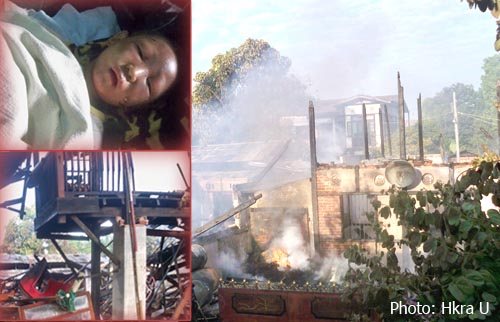Who would have thought that such a deadly unforgivable attack on Mr. Dayau Tang Gun’s house in Myitkyina was possible? His house was a multiple-use center, hosting orphans, the Band Baja cultural group, and internally displaced persons (IDPs). Altogether there were 40 people there, apart from some who rented places
Political Policy Branch
November 15, 2011
by The Kachin Think Tank Society (KTTS)
Who would have thought that such a deadly unforgivable attack on Mr. Dayau Tang Gun’s house in Myitkyina was possible? His house was a multiple-use center, hosting orphans, the Band Baja cultural group, and internally displaced persons (IDPs). Altogether there were 40 people there, apart from some who rented places when the attack took place on November 13, 2011. Mr. Dayau Tang Gun is known locally for his activities. He is the leader of the Band Baja, the Kachin Martial Arts group, and works for the Red Cross
There have been other explosions in governmental and public areas in Myitkyina, Waimaw and Mogawng since June. All of these events have made it clear to civilians in Kachin state that no one is safe.

This report attempts to place such violence within the framework of the current civil war between the Burmese military and the Kachin Independence Army (KIA). It assigns responsibility to the Burmese government and its military.
Critical overview
The attack left 14 dead and 27 injured in the house of Dayau Tang Gun. The blast ignited a fire that soon spread to two adjacent houses belonging to Hpaga Naw Ring and wife Hla Ngwi, and to Mr. Lashu Naw Awng and his wife Mashaw. The homeowners suffered the loss of significant property in the blaze. Dayau Tang Gun’s two-storey house was completely gutted in just 30 minutes. Firefighters were late to arrive which made putting out the inferno more difficult.
The explosion created a two-foot deep crater. Some victims were thrown 50 feet away.Most civilians on the second floor were killed and many on the ground floor were injured.
People in the area have expressed different theories. Some, in Thida Quarter, believe an unseen person triggered a “big and unusual bomb”. They have no proof, but blame the government. A second possibility has more support. This holds that two motorcycle riders went by the house and left a package that exploded. Whatever the cause, the result was nothing less than inhuman.
No one has yet accepted responsibility for the attack and, due to the high level of security, it has not been possible to undertake a meticulous investigation and clearly pin blame.
Analysis of the attack: the effects of ethnic war
In light of this attack and of the worsening conflict, this report focuses its analysis on the relationship between the Kachin Independence Organization/Army (KIO/A) and the military-backed government under President Thein Sein. Whether or not the authorities had any personal antagonism towards the owner of the house in Myitkyina is moot. Should to come to light that the government was in any way involved in the attack, it will thoroughly discredit its promotion of civil values
We believe the Burmese military is seriously violating international laws both in the way it conducts its military operations and in the weapons it uses. We believe the government’s military is increasing the amount and nature of such violations due to the heavy casualties it is suffering in its war with Kachin forces. Such violations have also been extended to Kachin civilian population.

ang-gun-mapWe would like to highlight in particular a recent heated conversation between Chief Minister Duwa Lajawn Ngan Seng and the head of Northern Command, Major General Ko Ko Naing. The topic was the civil war and the Kachin population.
At one point, the Major General declared, “… the Kachins are to be uprooted … this time.”
In response, and pounding a table, Duwa Ngan Seng said, “Why did you say this about all the Kachins? Do you mean to do this even to me since and I am also a Kachin….”
Our think tank believes that there is an implicit policy of ethnic cleansing in place. We believe the government sees Kachins as foes and not as co-inhabitants of the same state. This goes against any claims of democracy and is even an assault upon civilized values.
The violent attacks upon civilians that have taken place in Kachin need to be examined closely to reveal their underlying political contexts.
We also see the government as acting to split the Kachin movement and by doing so engender strife within the community and weaken the KIO/A. Their use of splinter groups such as: the New Democratic Army-Kachin (NDAK), the Lasang Awng Wa Militia Groups, the Kachin Defense Army (KDA)-Kawng Hka, the Ah Dang Militia Groups, the Tangbau Hkut Myat and three other groups from Kutkai serves well to illustrate this point.
Those groups do not represent majority Kachin opinion but were simply used to split the movement, to facilitate the run-up to the 2008 elections and to implement government policy, not just in political endeavors but in cultural, educational and economic matter as well.
We finish by stating that the real “stronghold” of the Kachin people lies with the KIO and the KIA. They have stood for federalism as the way forward.


